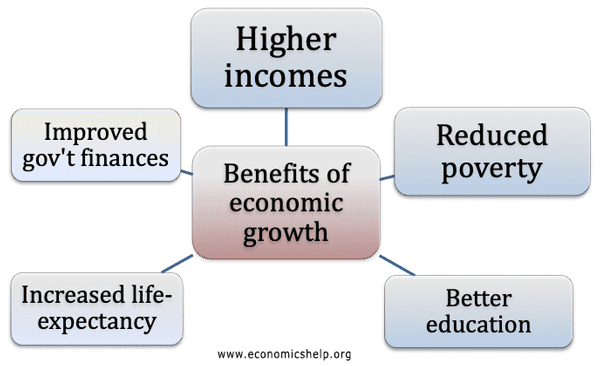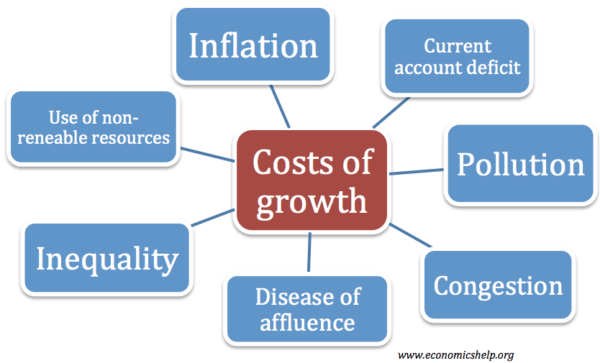AQA Specification focus:
‘The costs and benefits of economic growth.’
Economic growth brings opportunities and challenges. Understanding its costs and benefits helps assess its implications for individuals, businesses, governments, and the wider economy.
The Concept of Economic Growth
Economic growth refers to an increase in the real output of goods and services in an economy over time, usually measured by changes in real Gross Domestic Product (GDP).
Real GDP: The total value of goods and services produced in an economy, adjusted for inflation.
Growth can be driven in the short run by increased demand (demand-side factors) or in the long run by improvements in productive capacity (supply-side factors). These gains, however, come with potential trade-offs.
Benefits of Economic Growth
Higher Living Standards
Growth enables higher real incomes, leading to improved consumption and material well-being.
Access to better healthcare, education, and housing can raise quality of life.
Rising demand for goods and services stimulates production and employment.
Employment and Job Creation
Higher output usually requires more labour, reducing unemployment.
Firms may invest in training, boosting human capital and productivity.
More job opportunities can reduce poverty levels and income inequality if fairly distributed.
Fiscal Advantages for Governments
Strong growth increases tax revenues (income tax, VAT, corporation tax) without raising tax rates.
Governments can use this revenue to invest in public services and infrastructure.
Fiscal strength also allows for reduced borrowing, lowering the budget deficit and national debt pressures.
Investment and Innovation
Economic growth encourages firms to reinvest profits into research and development.
Innovation drives technological progress, increasing efficiency and long-run competitiveness.
Positive spillover effects arise when industries share new knowledge and practices.
International Competitiveness
A growing economy can attract foreign direct investment (FDI).
Higher productivity strengthens export performance, improving the balance of payments position.
A reputation for strong growth enhances a nation’s global economic influence.

This table summarises the benefits and costs of economic growth, providing a balanced view that aids evaluation of the advantages and disadvantages for an economy. Source
Costs of Economic Growth
Inflationary Pressures
Excessive growth in demand can cause demand-pull inflation, where aggregate demand exceeds productive capacity.
Wage growth and rising input costs may generate cost-push inflation.
If left unchecked, inflation reduces purchasing power and harms those on fixed incomes.
Environmental Degradation
Growth often leads to increased pollution, resource depletion, and loss of biodiversity.
Greater reliance on fossil fuels worsens climate change impacts.
Long-term damage to ecosystems can undermine future productive capacity.
Inequality Concerns
Growth may disproportionately benefit the wealthy, widening the income gap.
Regional disparities may emerge if growth is concentrated in specific industries or cities.
Social tensions can rise if prosperity is not equitably shared.
Balance of Payments Problems
Rising incomes may increase demand for imports, worsening the current account.
If growth is import-led, domestic producers may not benefit as strongly.
Trade deficits can lead to currency depreciation and external debt pressures.
Unsustainable Expansion
Rapid growth can fuel boom-and-bust cycles, creating economic instability.
Overinvestment in certain sectors (e.g., property markets) can cause asset bubbles.
When bubbles burst, recessions can follow, leading to unemployment and falling living standards.

This diagram illustrates the main costs of economic growth, including inflation, environmental damage, and inequality, highlighting the trade-offs that accompany rising output. Source
Evaluating the Trade-Offs
Short-Run vs Long-Run Impacts
In the short run, higher output reduces unemployment and boosts consumption.
In the long run, if growth is based on sustainable investment, it raises trend growth.
However, short-run overheating risks inflation and financial instability.
Quality vs Quantity of Growth
Growth focused on inclusive development can reduce inequality and improve welfare.
If growth is narrowly based on resource extraction, it may lack sustainability.
Long-term benefits depend on structural reforms, investment in skills, and environmental protection.
Social and Political Implications
Rising incomes may improve social cohesion if benefits are widely shared.
If inequalities rise, political discontent and instability may follow.
Governments must balance promoting growth with safeguarding fairness and sustainability.
Opportunity Costs of Growth
Resources directed at rapid expansion may reduce focus on public goods such as healthcare or defence.
Overemphasis on GDP growth can neglect non-economic indicators of welfare, such as happiness and leisure.
Key Judgement for AQA Students
Economic growth provides multiple benefits including higher living standards, employment, and fiscal strength, but also brings costs such as inflation, inequality, and environmental harm. Understanding these trade-offs is central to evaluating economic performance.
FAQ
Sustainable growth occurs when output increases without depleting resources or harming future productive capacity. It balances economic progress with environmental and social responsibility.
Unsustainable growth relies heavily on resource exploitation, fossil fuels, or excessive borrowing, creating risks of environmental damage, financial instability, or falling living standards over time.
Governments can take steps to mitigate the costs by:
Introducing environmental regulations and green investment policies.
Using progressive taxation to reduce inequality.
Encouraging sustainable industries and renewable energy.
Applying monetary and fiscal policies to control inflation.
These measures ensure growth is both stable and equitable.
Growth does not guarantee equal distribution of income and wealth. If most benefits flow to high-income groups or specific regions, inequality widens.
Additionally, rising inflation may offset wage gains, while environmental harm could reduce overall quality of life despite higher GDP figures.
Economic growth often increases demand for imports, worsening the current account balance if domestic industries cannot compete.
However, higher productivity from growth may boost exports. A competitive export sector can help balance the effects of rising imports, but outcomes depend on the structure of the economy.
Technological progress can reduce costs by making production cleaner and more efficient, limiting environmental harm. It also drives long-run growth by improving productivity.
Yet rapid advances can worsen inequality if only skilled workers benefit or if industries relying on outdated methods collapse, causing structural unemployment.
Practice Questions
Define the term "economic growth" and explain how it is commonly measured. (2 marks)
1 mark for a correct definition of economic growth: an increase in the real output of goods and services in an economy over time.
1 mark for stating that it is commonly measured by changes in real Gross Domestic Product (GDP).
Discuss two possible costs of rapid economic growth for an economy. (6 marks)
Up to 2 marks for identifying each cost (maximum 4 marks if two distinct costs are given). Examples include:
Inflationary pressures (demand-pull or cost-push)
Environmental degradation
Worsening income inequality
Balance of payments problems
Risk of unsustainable growth and asset bubbles
Up to 2 marks for development/explanation of the identified costs, e.g.:
Inflation erodes purchasing power, particularly affecting those on fixed incomes.
Environmental damage can reduce long-term productive capacity.
Rising inequality can cause social and political tension.
Trade deficits from higher import demand may destabilise the currency.
Boom-and-bust cycles can cause long-term instability.
Application to the general economy is required for higher-level marks (e.g. linking costs to employment, fiscal policy, or future growth prospects).
Level descriptors for Question 2
1–2 marks: Simple identification of one or two costs with little or no development.
3–4 marks: Some explanation of at least one cost, but limited depth or range.
5–6 marks: Clear and well-developed discussion of two costs, with sound economic reasoning.

